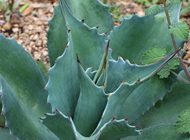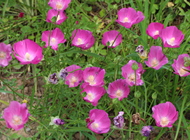 |
Garden journal entry |
 |

Robust underground growth on our Erythrina crista-galli volunteer |
May 27, 2025. I have an incentive to make the garden look extra nice, and keep it looking that way: we'll be hosting a family event in the backyard next year, and this is the trial year to see if we can keep things looking perky through a Houston summer, to provide a charming backdrop for our guests. So I've been keeping busy, taking greater care to rid known problem areas of troublesome weeds, getting rid of misplaced plants that I've allowed to grow where I know perfectly well they shouldn't, and just generally trying to picture what the garden could look like, and trying to get it there. One goal is to provide a greater sense of seclusion to our fenced-in backyard, hiding most of the fence. I got there once a few years ago, but freeze- and hurricane-induced tree and shrub losses opened up some new gaps, and the goal is to extend the tapestry above fence height, to hide more of the neighboring homes. One conspicuous gap is in the back left corner of the yard, where I took out a struggling fig last year. Another fig is still doing well there, but the other shrubs in the vicinity aren't tall enough to obscure the fence, let alone the neighbors' house – so Amy set me a challenge to come up with some taller things to grow there. So this week, I transplanted a sucker from our abundantly growing Lespedeza 'Little Volcano', which will fill in part of the backdrop. For the other, I had in mind a volunteer coral bean, which had seeded not far from its mother plant a couple years ago. It was definitely one of aforementioned misplaced plants, as it was growing towards the front of the border where its thorns were likely to cause problems (and snag those prospective guests), so I was intent on moving it to the gap area, closer to the fence. It wasn't a particularly large plant, so transplanting should be easy – or so I thought. I soon found out it would be a more significant operation: when I tried to lift it, I found that the plant arose from an underground stem about six inches in diameter (much more robust than the above-ground growth), which extended quite a ways into the soil. And that soil wasn't easy to dig into, after several weeks of hot and dry weather. So I spent a couple of hours painstakingly excavating soil from around an ever-increasing hole a trowelful at a time, periodically soaking the hole to give said trowel more purchase in the hard clay. But even after all that effort, the darn thing wouldn't budge even a fraction of an inch when I tried to get a shovel underneath it or to dislodge it with both hands. Finally, in frustration, I laid down on the ground next to it and kicked it as hard as I could. Luckily, that did it: it gave a fraction of an inch, then an inch, and then yielded enough for me to get at the roots below holding it so firmly in place, allowing me to finally extract it. The photo here shows what it looked like with most of its top growth removed to facilitate the digging operation. After snapping its picture, I set it in its new home, where thus far it seems to be doing OK, despite the rough treatment it got. With some luck, it will zoom up high above the fence by this time next year, much like its momma already does right around the corner. |
Last modified:
September 09, 2009
Contact me
|